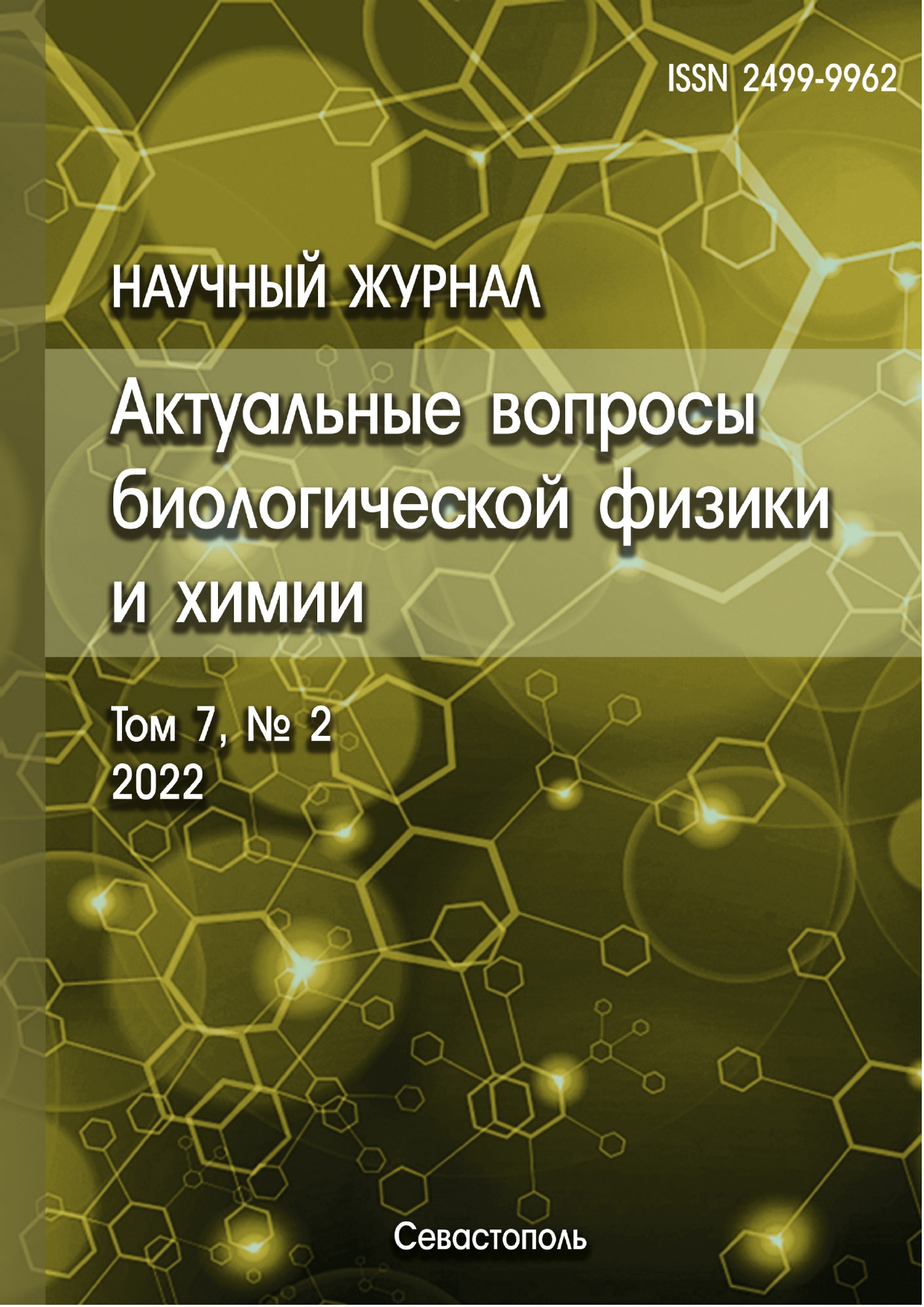Yerevan, Armenia
Yerevan, Armenia
Yerevan, Armenia
Yerevan, Armenia
Interaction of dye-intercalator methylene blue (MB) with single-stranded (ss-) polynucleotides poly(rA), poly(rU) and double-stranded poly(rA)-poly(rU) has been studied by the method of absorption spectroscopy at various concentration ratios ligand/phosphate (concentration of ss-polynucleotides by phosphate residue). It was revealed that in the absorption layer of methylene blue, in the wavelength change interval 500≤λ≤750 nm, the absorption spectra of the complexes MB-ss-poly(rA) decrease more sharply, as compared to MB spectrum, along with polynucleotide concentration enhancement in the solution. It was also revealed that the absorption spectra of the complexes MB-ss-poly(rU) decrease moderately at the increase of this polynucleotide concentration in the solution. In the spectra of the complexes MB-ss-poly(rU) a pseudo-isosbestic point is formed, while in the spectra of the complexes MB-ss-poly(rA) there is no such point. The pseudo-isosbestic point is formed also in the spectra of the complexes MB-poly(rA)-poly(rU). It was also revealed that the absorption spectra of the complexes of MB with ss-poly(rA) and poly(rA)-poly(rU) are shifted to the longer wavelengths by ~5-7 nm, while the shift in the absorption spectra of the complexes MB-ss-poly(rU) composes almost ~2 nm. The absorption spectra changes of the complexes of MB with the mentioned polynucleotides indicate that MB shows higher specificity to poly(rA), as compared to poly(rU) and poly(rA)-poly(rU). The obtained data also indicate that MB binds to poly(rA) and poly(rA)-poly(rU) by intercalation and electrostatic modes, and with ss-poly(rU) – mainly by electrostatic mechanism.
methylene blue, semi-intercalation mechanism, poly(rA), poly(rU), poly(rA)-poly(rU), electrostatic binding, absorption spectra
1. Kankia B.I. Mr2+-induced triplex formation of an equimolar mixture of poly(rA) and poly(rU). Nucl. Acids Res., 2003, vol. 31, no. 17, doi:https://doi.org/10.1093/nar/gkg698. EDN: https://elibrary.ru/XRNHUE
2. Andrushchenko V., Blagoi Yu., van de Sande J.H., Wieser H. Poly(rA)•Poly(rU) with Ni2+ Ions at Different Temperatures: Infrared Absorption and Vibrational Circular Dichroism Spectroscopy. J. of Biomol. Struct. & Dyn., 2002, vol. 19, no. 5, doi:https://doi.org/10.1080/07391102.2002.10506792.
3. Vardevanyan P.O., Antonyan A.P., Parsadanyan M.A., Shahinyan M.A. Study of the influence of the ionic strength on complex-formation of ethidium bromide with poly(rA)-poly(rU). J. of Biomol. Struct. & Dyn., 2020, vol. 38, no. 8, doi:https://doi.org/10.1080/07391102.2019.1630006.
4. Dower K., Kuperwasser N., Merrikh H., Rosbash M. A synthetic A tail rescues yeast nuclear accumulation of a ribozyme-terminated transcript. RNA, 2004, vol. 10, doi:https://doi.org/10.1261/rna.7166704.
5. Svitkin Y.V., Sonenberg N. An efficient system for cap- and poly(A)- dependent translation in vitro. Meth. Mol. Biol., 2004, vol. 257, doi:https://doi.org/10.1385/1-59259-750-5:155.
6. Alvarez E., Castello A., Menendez-Arias L., Carrasco L. HIV protease cleaves poly(A)-binding protein. Biochem J., 2006, vol. 396, doi:https://doi.org/10.1042/BJ20060108.
7. Pradhan A.B., Haque L., Das S. Binding of Phenazinium Dye Safranin T to Polyriboadenylic Acid: Spectroscopic and Thermodynamic Study. PLOS ONE, 2014, vol. 9, no. 2, doi:https://doi.org/10.1371/journal.pone.0087992. EDN: https://elibrary.ru/YEDSGT
8. Tian B., Hu J., Zhang H., Lutz C.S. A large-scale analysis of mRNA polyadenylation of human and mouse genes. Nucleic Acids Res., 2005, vol. 33, 201-212. DOI:https://doi.org/10.1093/nar/gki158 EDN: https://elibrary.ru/XOOIAF
9. Bojadzic D., Alcazar O., Buchwald P. Methylene Blue Inhibits the SARS-CoV-2 Spike-ACE2 Protein-Protein Interaction-a Mechanism that can Contribute to its Antiviral Activity Against COVID-19. Front. Pharmacol., 2021, doi:https://doi.org/10.3389/fphar.2020.600372.
10. Bistas E., Sanghavi D. Methylene blue. (Treasure Island, FL: StatPearls), 2020.
11. Dicko A., Roh M.E., Diawara H., Mahamar A., Soumare H.M., Lanke K. et al. Efficacy and safety of primaquine and methylene blue for prevention of Plasmodium falciparum transmission in Mali: a phase 2, single-blind, randomised controlled trial. Lancet Infect. Dis., 2018, vol. 18, no. 6, doi: 10.1016/ s1473-3099(18)30044-6.
12. Cagno V., Medaglia C., Cerny A., Cerny T., Tapparel C., Cerny E. Methylene blue has a potent antiviral activity against SARS-CoV-2 in the absence of UV-activation in vitro, 2020.
13. Gendrot M., Andreani J., Duflot I., Boxberger M., Bideau M.L., Mosnier J., Jardot P., Fonta I., Rolland C., Bogreau H., Hutter S., La Scola B., Pradines B. Methylene blue inhibits replication of SARS-CoV-2 in vitro. Int. J. Antimicrob. Agents., 2020, vol. 56, doi:https://doi.org/10.1016/j.ijantimicag.2020.106202. EDN: https://elibrary.ru/NGYYSX
14. Vardhana S.A., Wolchok J.D. The many faces of the anti-COVID immune response. J. Exp. Med., 2020, vol. 217, no. 6, doi:https://doi.org/10.1084/jem.20200678.
15. Di Cosimo S., Malfettone A., Perez-Garcia J.M., Llombart-Cussac A., Miceli R., Curigliano G., Cortes J. Immune checkpoint inhibitors: a physiologydriven approach to the treatment of coronavirus disease 2019. Eur. J. Canc., 2020, vol. 135, doi:https://doi.org/10.1016/j.ejca.2020.05.026.
16. Liu P.P., Blet A., Smyth D., Li H. The science underlying COVID-19: implications for the cardiovascular system. Circulation., 2020, vol. 142, doi:https://doi.org/10.1161/CIRCULATIONAHA.120.047549. EDN: https://elibrary.ru/WUZTTP
17. Ye Q., Wang B., Mao J. The pathogenesis and treatment of the ‘cytokine storm’ in COVID-19. J. Infect., 2020, vol. 80, no. 6, doi:https://doi.org/10.1016/j.jinf. 2020.03.037.
18. Acharya V.V., Chaudhuri (Chattopadhyay) P. Modalities of Protein Denaturation and Nature of Denaturants. Int. J. Pharm. Sci. Rev. Res., 2021, vol. 69, no. 2, doi:https://doi.org/10.47583/ijpsrr.2021.v69i02.002.
19. Nedu M.-E., Tertis M., Cristea C., Georgescu A.V. Comparative Study Regarding the Properties of Methylene Blue and Proflavine and Their Optimal Concentrations for In Vitro and In Vivo Applications. Diagnostics, 2020, vol. 10, doi:https://doi.org/10.3390/diagnostics10040223.
20. Sani N.D.Md., Ariffin E.Y., Sheryn W., Shamsuddin M.A., Heng L.Y., Latip J., Hasbullah S.A., Hassan N.I. An Electrochemical DNA Biosensor for Carcinogenicity of Anticancer Compounds Based on Competition between Methylene Blue and Oligonucleotides. Sensors, 2019, vol. 19, doi:https://doi.org/10.3390/s19235111. EDN: https://elibrary.ru/DAEZKC
21. Vardevanyan P.O., Antonyan A.P., Parsadanyan M.A., Shahinyan M.A., Sahakyan V.G. Peculiarities of interaction of synthetic polyribonucleotide poly(rA)-poly(rU) with some intercalators. J. of Biomol. Struct. & Dyn., 2018, vol. 36, no. 14, doi:https://doi.org/10.1080/07391102.2017.1402708.
22. Vardevanyan P., Antonyan A., Parsadanyan M., Torosyan M., Karapetian A. Joint interaction of Ethidium Bromide and Methylene Blue with DNA. The effect of ionic strength on binding thermodynamic parameters. J. of Biomol. Struct. And Dyn., 2016, vol. 34, no. 7, doi:https://doi.org/10.1080/07391 102.2015.1079557. DOI: https://doi.org/10.1080/07391102.2015.1079557; EDN: https://elibrary.ru/WTPMMJ










